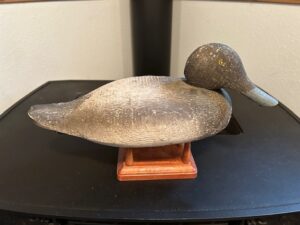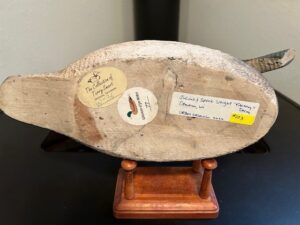A Decoy Corner Article
By Bruce Urben, WWA President
Photos courtesy Bruce Urben from his private collection
The Decoy Corner has highlighted many very talented Wisconsin carvers, most of whom used hand and some power tools to cut, shape and detail their decoys. For most, their decoys were carved out of need, tools to lure ducks to their shotgun. But, some came into the decoy carving game as a business.
This article is about a small (very small) decoy carving operation believed to be run by the father and son team of Julius and Speck Voight from Cameron, WI.
The Village of Cameron is located in northwest Wisconsin’s Barron County. Cameron was settled in the 1880’s and is named after Angus Cameron, a U.S. Senator from Wisconsin. The Cameron area was a waterfowlers mecca in the Northwoods, with many lakes and chains filled with native wild rice and celery. Prime forage for migrating waterfowl.
In 1938, Julius Voight purchased the duplicating lathe from the Walter Evans Decoy Co. in Ladysmith, WI, when they finally closed their doors. The Voight Decoy “factory” began carving decoys in the early 1940’s through the early 1960’s. It was believed to be a father (Julius) and son (Speck) operation. History tells us that the Voights owned a sawmill in Cameron, which supplied the raw material for their decoys.
Not much has been documented about the number of decoys produced by the Voight operation. We do know that several species were produced, including bluebills and mallards. All of their decoys were turned on the duplicating lathe, two at a time!
Distinguishing details that separate Voight wood decoys from other lathe carved blocks (Evans, Masons and Animal Trap) were the heads and tails on their bodies. Voight heads were carved two at a time and attached at the bill of each other. Most of the decoy heads were crudely separated at the bill, which caused inconsistently shaped bills on most of their decoys. The tails on the bodies were also inconsistent, as some were abruptly cut and many were tapered. The tail itself is more square cut than other factory decoys of that time.
We know that Voight produced decoys with painted eyes and a few with glass eyes. Most, if not all, of his decoys are feather carved, meaning the lathe cut lines were not sanded and are visible. Many waterfowlers believe that these lathe lines actually softened the appearances and reduced glare on the water.
History also tells us that Voight decoys were produced through the early 1960’s, but it is unclear when they went out of business. We do know that this carving factory produced a hunting decoy that worked well and was affordable at the time.
Voight Decoys are not highly collected, probably because of their limited output, but several examples have been sold at auction in the last few years for several hundred dollars.
I am fortunate to have a confirmed Voight Bluebill decoy (ca. 1950’s) in my collection from the “Terry Smart” collection. Terry was a decoy collector, attorney, president of the Evans Decoy Collectors and a dear friend from Tennessee who passed away in June of 2022.
Voight “factory” decoys, another Wisconsin original!


